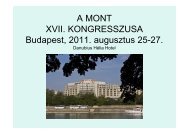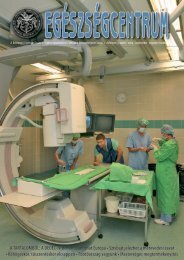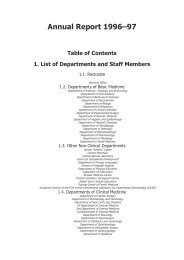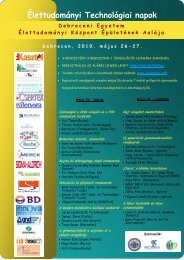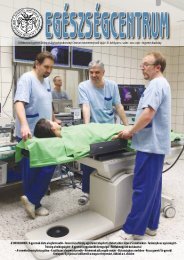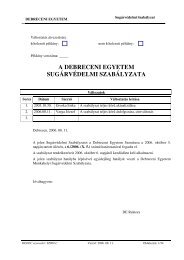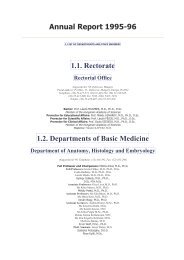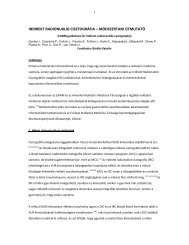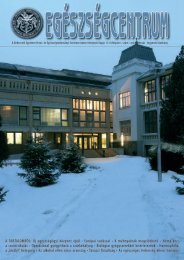Vertigo and Dizziness - neurology presentations
Vertigo and Dizziness - neurology presentations
Vertigo and Dizziness - neurology presentations
- No tags were found...
You also want an ePaper? Increase the reach of your titles
YUMPU automatically turns print PDFs into web optimized ePapers that Google loves.
<strong>Vertigo</strong> <strong>and</strong><strong>Dizziness</strong>causes, diagnostics,therapyDr. Molnár Sándor6 September 2010
Definition„<strong>Vertigo</strong> is total or partial loss of spatialorientation, a rotation feeling of thesurroundings”(Révész)„<strong>Vertigo</strong> is a discrepancy between objective<strong>and</strong> subjective spatial relations”(Horányi)An illusoric feeling of movement of the body orthe surroundings
Development of vertigoVestibular – Optical - Somatosensoryconflicting afferent informationEfferentOculomotor system VOR (nystagmus)Spinal cord musculature balance (ataxia)Parietotemp. cortex spatial orientation (vertigo)Vegetative system(vomitus)
Types of vertigo<strong>Vertigo</strong>• A sense of feeling the environment moving whenit does not. Persists in all positions. Aggravatedby head movement.Dysequilibrium• A feeling of unsteadiness or insecurity withoutrotation. St<strong>and</strong>ing <strong>and</strong> walking are difficult.Light headedness• Swimming, floating, giddy or swaying sensationin the head or of the room.
Symptoms of vertigo ofperipheral originCause: lesion of the labyrinth <strong>and</strong> vestibular nerve• harmonic vestibular syndrome• consistent direction of tilt, past pointing, blind walking<strong>and</strong> slow component of the nystagmus• nystagmus: horisontal or horisonto-rotatory, neververtical• direction of nystagmus is independent of gaze direction(I. II. III. grade nystagmus)• symptoms intensified by change of head position• frequently intensive vegetative symptoms (vomiting,sweating, paleness)• mortal fear can develop• decreased vestibular function on lesion side
<strong>Vertigo</strong> of central originCause: lesion of vestibular nucleus other CNS lesion• dysharmonic vestibular syndrome (can be harmonic as well!)• direction of nystagmus can change with gaze direction• nystagmus is not supressed by vizsual fixation• nystagmus can be up- or downbeat or rotatory,or even dissociated• dizzy feeling not severe <strong>and</strong> mostly not rotatory• symptoms not intensified by change of head position• vegetative symptoms less severe• other neurol. symptoms: double vision, dysarthric speech,dysphagia, numbness, paresis, ataxia etc.
• Type of vertigo• Duration• TriggerHistoryrotatory / postural / atypicalseconds / minutes / hours / continuous / recurrentno / walking / head rotation / certain head positions /coughing / pressing / loud sounds / life situations• Accompanying symptomshypacusis / tinnitus / double vision / ataxia / nystagmus/ oscillopsy / brainstem or cerebellar symptoms / headache
Diff. Dg. by symptom durationTime Perpheral CentralSeconds BPPV VBI-TIA, epilepsyauraMinutes labyrinth fistule VBI-TIA, migraineauraHours Meniére disease basilar migraineDaysWeeks, monthsvestibular neuronitis,labyrinthitisvestibularSchwannoma,ototoxicityVB strokemultiple sclerosis,cerebellardegeneration
Special examination tecniques• Eye movements• saccadic, smooth pursuit• Nystagmus• spontaneous, gaze evoked, hyperventilation• Frenzel glasses, to eliminate fixation• Halmágyi-Curthoys manoeuvre (head impulse test)• horisontal VOR• unilateral labyrinth laesion catch-up saccad• Dix-Hallpike manoeuvre• positional nystagmus, BPPV• Statokinetic tests• Romberg• blind walking, star walking• Bárány test
Dix-Hallpike manoeuvre
Special examination tecniques• Labyrinth stimulating tests• head shaking test (30 sec) – unilateral lesion• vibration induced nystagmus (60 Hz) – unilateral lesion• caloric test – gold st<strong>and</strong>ard in unilateral lesion• rotational test• Pressure change• Politzer balloon,• tragus compression, Valsalva manoeuvre• Optokinetic nystagmus• poorly cooperating patients• Subjective visual vertical• tilt towards the lesion by 10-30 ° (norm: 0° + 2,5°)• Hyperventilation• cerebellar lesion – downbeat nystagmus• vestibular paroxysmia
Role of CT <strong>and</strong> MR• Brain CT or MRI is indicated if suspiction ofintracranial pathology• High resolution pyramid bone CT:– 0,6 mm slices, resolution: 0,4x0,4x0,4 mm– Indication:• os petrosum fracture• superior canal dehiscence syndrome• labyrinth ossification: Cogan sy., otosclerosis• Os petrosum <strong>and</strong> posterior fossa MR:– neurovascular compression– Cogan syndrome, labyrinthitis, cochlear inflammation
Most frequent causes (Br<strong>and</strong>t)• BPPV (otolith) 18,3%• Phobic postural vertigo (PPV) 15,9%• Central vestibular vertigo 13,5 %• Vestibular / basilar migraine 9,6 %• Vestibular neuronitis (viral) 7,9%• Menière disease (hydrops) 7,8%• Bilateral vestibulopathy 3,6%• Psychogenic vertigo (except PPV) 3,6%• Vestibular paroxysmia (neurovasc. compr) 2,9 %• Perilymphatic fistule (incl. Posttraumatic) 0,4%• Other 12,3%• Unknown 4,2%
Further peripheric causes• Labirynthitis (cochlea r involvement)• Commotion of the labyrinth, pyramid fracture• Cochlear infarct (a. labyrinthi occlusion)• Alternobaric vertigo (alternobaric)• Posttraumatic otolith vertigo• Herpes zoster oticus• Vestibulotoxic agents– aminoglicosides, salicilic acid, antiepileptics
Most frequent central causes• Brainstem stroke or TIA• Multiple Sclerosis• Basilar / vestibular migraine• Tumors of the posterior fossa• Syringobulbia• Arnold - Chiari malformation• Cerebellar atrophy, degeneration• Temporal lobe epilepsy
Systematic causes• Hypertension• Presyncope states, eg. orthostatic hypotension• Carotid sinus hyperaesthesia, vasovagal attacks• Aritmias• Hyperventilation• Hypo – hyperglycaemia• Aortic or mitral valve stenosis• AMI• Obstructive cardiomyopathy• Aortic dissection• Pulmonal emboli• Cardiac insufficiency• Anaemia• Hyperviscosity syndrome• Addison disease• Salt wasting• Intoxication
General therapySymptomatic, during acute vestibular attack• vestibular supressants• AntiemeticsBalance training, vestibular rehabilitation• enhancing central compensationSurgical (rare)• tumors, cavernomas• neurovascular compression• perilymphatic fistule• rarely Meniére, BPPVPsichological, psychiatric• PPV, acrophobia
Symptomatic therapyVestibularis supressants:• benzodiazepines• dimenhydrinat; promethazine• hydroxyzine• cinnarizine; flunarizine• Antiemetics:• Anti-dopaminergic: haloperidol, metoclopramid,domperidon• Anticholinergic-antihistamine: dimenhydrinat,promethazine, ondansetron
<strong>Vertigo</strong> syndromes ofperipheral cause
BPPVBenign paroxysmal positional vertigo• Bárány 1921• >70 yrs 1/3• Max 30-60 seconds• Certain head positions provocate the attacks• Nystagmus appears after latency, fixed direction,crescendo- decrescendo• Cause: canalolithiasis: most frequently posteriorsemicircular canal• No spontaneous nystagmus, no hearing loss, no calorictest abnormality• 90% idiopathic, some posttraumatic, post neuronitis,long term bedridden state• 10-20% bilateral
BPPV therapy• Drugs not help!!!• Repositional / liberating manoeuvres(80-95 % succes)Semont
PPV phobic postural vertigo• 2. most frequent cause of dizziness• Age: 2. <strong>and</strong> 5. decades• Instability feeling in upright posture• Fear attacks of falling, stumbling, lurching withanxiety <strong>and</strong> vegetative symptoms• Small amount of alcohol, sports: improvement• Frequently in certain situations (crowd, bridge,driving, etc.)• Escalates, avoiding behaviour develops
PPV phobic postural vertigo• Personality: obscessive-compulsiveor perfectionist• Physical examination: negative!• Therapy:– informing, desensitisation, behaviour therapy– antidepressants (SSRI, TCA)
Vestibular neuritis• Harmonic vestibular syndrome• Complete vestibular function recovery only in 40%!!• Later BPPV or PPV can occur• Therapy:– Vestibular supressants– Metilprednisolone: within 3 days, 100 mg/day, taperingevery 3 days by 20 mg, up to 3 weeks!?;much better residual vestibular function!!– Circulation enchancing infusions are ineffective!!– Vestibular training
Menière disease• Tipical attack:– Harmonic syndrome direction change during attack!!!– tinnitus, hearing loss, fullness in the ear– Hours (> 20 min), max. 12 hours– Excitation, later vestibular loss– Progressive hearing <strong>and</strong> vestibular function loss• 4.-6. decades male dominance• Vestibular drop attacks Tumarkin’s otolith crisis• Therapy:– Vestib. supressants– Profilaxis: Betahistin 3 x 40-48 mg for 6-12 months!– If ineffective, hydrochlorothiazide, triamteren– Rarely intratympanal gentamycin injections. Surgery ineffective.
Bilateral vestibulopathy• Oscillopsy during head movement <strong>and</strong> walking• Insecurity of walking in darkness <strong>and</strong> uneven surface• Disturbance of spatial orientation <strong>and</strong> memory• Loss of VOR, Halmágyi test positive bilaterally• Romberg extremely affected• Hearing loss can be present
Bilateral vestibulopathy• Aetiology:– ototoxikus medications: aminoglycoside, aspirin, diuretics,chemotherapeutics– cerebellar degeneration, MSA, SCA– meningitis, labyrinthitis: bacterial, TBC, HIV– tumors: neurofibromatosis type II.;– autoimmune: Cogan, Bechet, SLE, RA, PAN, giant cellarteritis– neuropathies– bilateral Meniére– Paget, bilat. Pyramid fracture• Therapy: prevention immunsupressants
Vestibular paroxysmia• Short lasting vertigo or postural imbalance attackslasting for seconds, max. minutes with severerotatory nystagmus• Tinnitus, hypacusis can be present• Vestibular <strong>and</strong> cochlear deficit can develop• Trigger: certain head position, hyperventilation• Carbamazepine reduces or stops attacks• No brainstem signs• Sometimes facial nerve excitation• 5.-7. decades, male predominance
• Aetiology:Vestibular paroxysmia– neurovascular cross-compression– segmental, pressure induced demyelinisation of the central(oligodendroglia) myelin cover, spontaneous discharges– AICA is the most frequent cause– arachnoidal cyst, aneurysm, vascular malformation
Vestibular paroxysmia• Therapy: carbamazepine 200-600 mg/die• rapid effect, diagnostic• oxcarbezepine, gabapentin, valproat, phenytoin• Surgical decompression should be avoided:• Hearing loss, stroke, side?, 50-60% success• Diff dg:• BPPV, migraine, PPV, epizodic vertebral arteryocclusion, brainstem paroxysms (SM)
Perilymphatic fistula• Attacks lasting seconds-days:– rotatory or postural vertigo– oscillopsia, usually vertical- rotatory nystagmus– st<strong>and</strong>ing, walking imbalance– hearing loss can be present• Trigger: pressure change– coughing, sneezing, Valsalva, loud sounds, bendingover, flights, extreme hights• History:– barotrauma, head trauma, ear trauma
Perilymphatic fistula• Provocating tests:– Valsalva manoeuvre, tragus compression, Politzer balloon• Exam: HR-CT, tympanoscopy• Cause:– dehiscence of superior semicircular canal– fistula between perilymphatic space <strong>and</strong> middle ear at theoval- or round window– Intracranial or middle ear pressure reaches the labyrinth
Perilymphatic fistula• Conservative therapy:– 1-3 weeks of bedrest– laxatives, moderate physical excercises for weeks– almost always succesful• Surgical therapy:• Closing of the fistula (ENT, neurosurgeon)• success rate 70%• Diff. dg:• BPPV, PPV, Meniére, v. paroxysmia, central cause
<strong>Vertigo</strong> syndromes ofcentral origin
Basilar / vestibular migraine• Recurrent attacks:– vertigo, ataxia, visual disturbance, otherbrainstem signs– occipital headache, nausea, vomitus– altered consciousness, mood change• Only vertigo or hearing loss:– vestibular migraine– 75% of the cases, hard to recognize!• Duration: seconds - days
Basilar / vestibular migraine• Therapy:– as in normal migraine– Antiemetics, NSAIDs– triptanes: carefully, danger of VBI !!– profilactic: beta blockers, valproic acid• Diff dg:– TIA, vertebral artery dissection, basilar arteryocclusion
Brainstem ischemiaPICA areaWallenberg syndromeMultiple SclerosisBrainstem <strong>and</strong> cerebellarmetastasesSyringobulbia-myeliaArnold-Chiari malformation
Other causes• Kinetosis• Height vertigo• Sensory deprivation (neuropathy, visual loss)• Cervicogenic???• Psychiatric disorder (panic, acrophobia)• Familiar Episodic Ataxia Type1-2• Autoimmune (Cogan, Bechet, Wegener, SLE, vasculitis, RA,APL)




